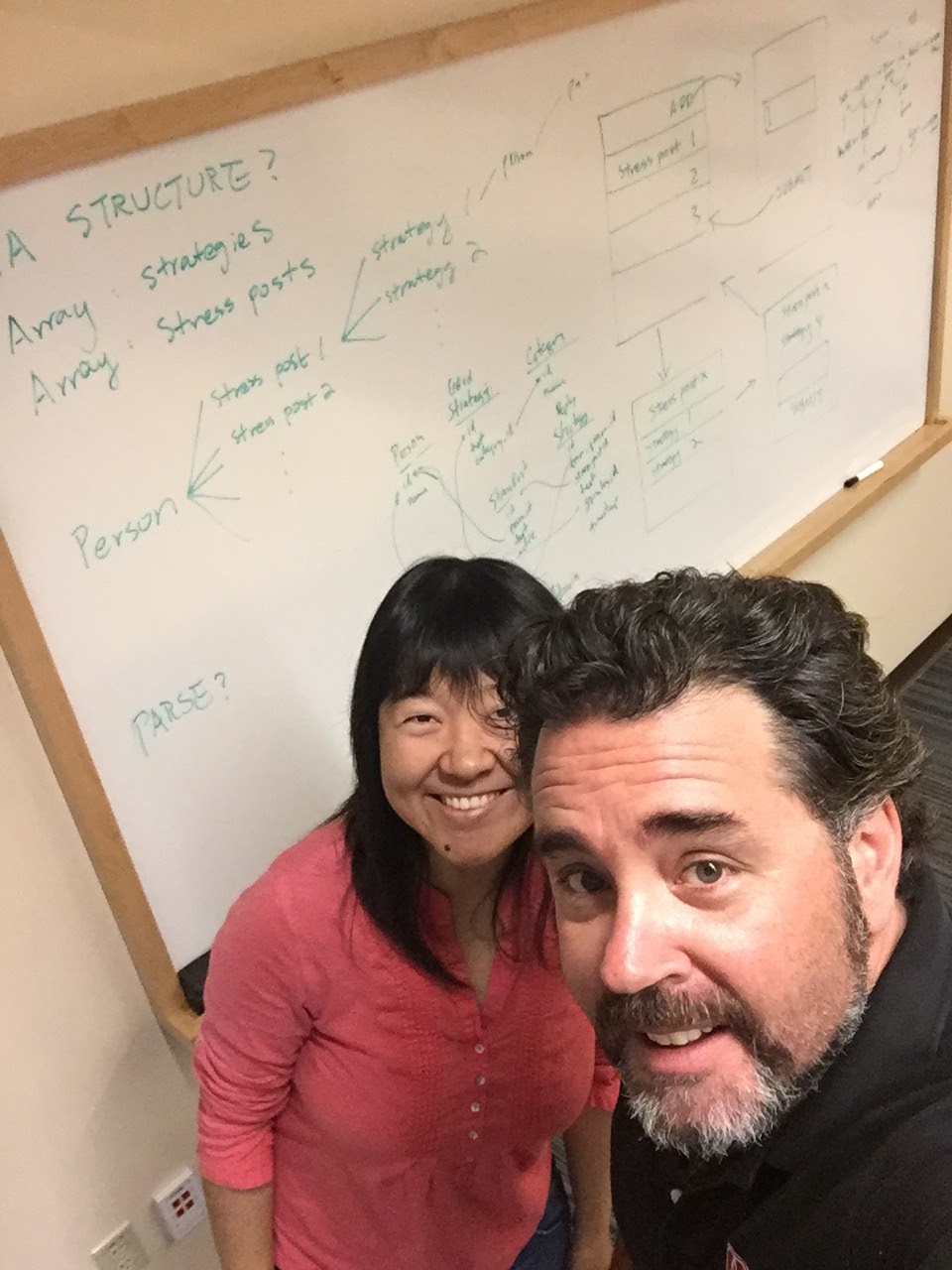Reading:
Jesse, S. (2008). The Art of Game Design. A book of Lenses.
Chapter 11 – Game Mechanics Must be in Balance
Summary:
This article furthers my awe of game development. It must be one of the hardest things to do well. I know from experience that the skills, time, and planning needed to program a game is leaps and bounds more complex than to program a mobile app or a web site. I also know that the graphics, which in most case have to be moving, are of extreme importance in a game. Again, it seems much harder to do art for games than to do art for a magazine, website, or mobile app. Then you have the storyline, the game mechanics, and all the factors mentioned in this article. This article is obviously assuming that you already have developed a game that can be balanced. I keep thinking of all the planning, design, development, and testing that goes on when creating a game. Obtaining balance is already hard in life; now try doing that in a game!
Notes:
The Twelve Most Common Types of Game Balance
- Fairness
- Symmetrical Games
- All players have equal powers.
- Random assignment resolves small potential asymmetries
- Asymmetrical Games
- Simulate real-world situations: it’s not symmetric
- Ways to explore the game-space: customize characters and strategies
- Personalization: shape game to suit their skill level
- Level playing field: opponent car’s must go slower at first
- Interesting situations: provocations, stimulate curiosity
- Example: Biplane Battle
- Choose from 3 planes with speed, maneuverability, and firepower
- Can balance on numbers alone but must play-test them to really feel it
- Takes around 6 months to balance your game properly
- Example: Rock Paper Scissors
- None of the elements are supreme
- Lens of Fairness
- Should my game be symmetrical? Why?
- Should my game be asymmetrical? Why?
- Which is more important: that my game is a reliable measure of who has the most skill, or that it provide an interesting challenge to all players?
- If I want players of different skill levels to play together, what means will I use to make the game interesting and challenging for everyone?
- Challenge vs. Success
- Strategies
- Increase difficulty with each success
- Let player get through the easy parts first
- Create “layer of challenge”
- Let players choose the difficulty level
- Play-test with a variety of players
- Don’t make it impossible to win
- Lens of Challenge
- What are the challenges in my game?
- Are they too easy, too hard, or just right?
- Can my challenges accommodate a wide variety of skill levels?
- How does the level of challenge increase as the player succeeds?
- Is there enough variety in the challenges?
- What is the maximum level of challenge in my game?
- Meaningful Choices
- Bad choices
- 50 equal vehicles to choose from = no choice at all
- A choice no-one wants
- Dominant strategy
- One option might win over all others – not good – need to adjust balance
- If Choices > Desires, then the player is overwhelmed.
- If Choices < Desires, the player is frustrated.
- If Choices = Desires, the player has a feeling of freedom and fulfillment.
- Lens of Choices
- What choices am I asking the player to make?
- Are they meaningful? How?
- Am I giving the player the right number of choices? Would more make them feel more powerful? Would less make the game clearer?
- Are there any dominant strategies in my game?
- Triangularity
- Choices
- Play it safe -> small reward
- Big risk -> big reward
- “Balanced asymmetric risk”
- Lens
- Do I have triangularity now? If not, how can I get it?
- Is my attempt at triangularity balanced? That is, are the rewards commensurate with the risks?
- Skill vs. Chance
- Lens of Skill vs. Chance
- Are my players here to be judged (skill), or to take risks (chance)?
- Skill tends to be more serious than chance: Is my game serious or casual?
- Are parts of my game tedious? If so, will adding elements of chance enliven them?
- Do parts of my game feel too random? If so, will replacing elements of chance with elements of skill or strategy make the players feel more in control?
- Head vs. Hands
- Hard to balance and some games have both
- Lens
- Are my players looking for mindless action, or an intellectual challenge?
- Would adding more places that involve puzzle-solving in my game make it more interesting?
- Are there places where the player can relax their brain, and just play the game without thinking?
- Can I give the player a choice — either succeed by exercising a high level of dexterity, or by finding a clever strategy that works with a minimum of physical skill?
- If “1” means all physical, and “10” means all mental, what number would my game get?
- This lens works particularly well when used in conjunction with Lens #16: Lens of the Player.
- Competition vs. Cooperation
- Animal urges
- Most games are competitive in nature
- Collaborate to compete against machine
- Collaborate to compete against another team
- Lens of Competition
- Does my game give a fair measurement of player skill?
- Do people want to win my game? Why?
- Is winning this game something people can be proud of? Why?
- Can novices meaningfully compete at my game?
- Can experts meaningfully compete at my game?
- Can experts generally be sure they will defeat novices?
- Lens of Cooperation
- Cooperation requires communication. Do my players have enough opportunity to communicate? How could communication be enhanced?
- Are my players friends already, or are they strangers? If they are strangers, can I help them break the ice?
- Is there synergy (2 + 2 = 5) or antergy (2 + 2 = 3) when the players work together? Why?
- Do all the players have the same role, or do they have special jobs?
- Cooperation is greatly enhanced when there is no way an individual can do a task alone. Does my game have tasks like that?
- Tasks that force communication inspire cooperation. Do any of my tasks force communication?
- Lens of Competition vs. Cooperation
- If “1” is Competition and “10” is Cooperation, what number should my game get?
- Can I give players a choice whether to play cooperatively or competitively?
- Does my audience prefer competition, cooperation, or a mix?
- Is team competition something that makes sense for my game? Is my game more fun with team competition, or with solo competition?
- Short vs. Long
- Determined by win or loose conditions
- Timing is everything
- Lens
- What is it that determines the length of my gameplay activities?
- Are my players frustrated because the game ends too early? How can I change that?
- Are my players bored because the game goes on for too long? How can I change that?
- Setting a time limit can make gameplay more exciting. Is it a good idea for my game?
- Would a hierarchy of time structures help my game? That is, several short rounds that together comprise a larger round?
- Rewards
- Types
- Praise: good job
- Points: the more the merrier
- Prolonged play: keep going
- Gateway: access to a new level
- Spectacle: usually paired with other types of reward
- Expression: change clothes, decorate… fun
- Powers: more
- Resources: more
- Completion: I did it
- Rules of thumb
- People get acclimated to rewards
- Variable rewards
- Lens
- What rewards is my game giving out now? Can it give out others as well?
- Are players excited when they get rewards in my game, or are they bored by them? Why?
- Getting a reward you don’t understand is like getting no reward at all. Do my players understand the rewards they are getting?
- Are the rewards my game gives out too regular? Can they be given out in a more variable way?
- How are my rewards related to one another? Is there a way that they could be better connected?
- How are my rewards building? Too fast, too slow, or just right?
- Punishment
- Reasons to punish
- Creates endogenous value: resources are more valuable if they can be taken away
- Taking risks is exciting
- Increases challenge
- Types
- Shaming: “you loose”
- Loss of points: very painful
- Shortened play: loose a life
- Terminated play: game over
- Setback: go to last checkpoint
- Removal of Powers: slow down
- Resource depletion: loss of goods
- Better to reward than punish
- Punishments need to be understood and preventable – risk of being “unfair”
- Lens
- What are the punishments in my game?
- Why am I punishing the players? What do I hope to achieve by it?
- Do my punishments seem fair to the players? Why or why not?
- Is there a way to turn these punishments into rewards and get the same, or a better effect?
- Are my strong punishments balanced against commensurately strong rewards?
- Freedom vs. Controlled Experience
- Game isn’t a simulation of real life, rather more interesting
- Too much freedom becomes cumbersome
- Take control over experience when necessary – no problem
- Simple vs. Complex
- Kinds of complexity
- Innate complexity: too many rules or “exception cases” – hard to learn
- Emergent complexity: simple rules with complex situations – hard to achieve in the design of the game
- Lens of Complexity
- What elements of innate complexity do I have in my game?
- Is there a way this innate complexity could be turned into emergent complexity?
- Do elements of emergent complexity arise from my game? If not, why not?
- Are there elements of my game that are too simple?
- Neutral vs. Artificial Balancing
- Careful when adding innate complexity to balance game
- Elegance
- Game is simple to learn and understand, but full of emergent complexity
- Pac Man: short- and long-term goals for player, slow down when eating, points measure success
- Lens of Elegance
- What are the elements of my game?
- What are the purposes of each element? Count these up to give the element an “elegance rating.”
- For elements with only one or two purposes, can some of these be combined into each other, or removed altogether?
- For elements with several purposes, is it possible for them to take on even more?
- Character
- Having a personality is a good thing (Tower of Pisa)
- Lens of Character
- Is there anything strange in my game that players talk about excitedly?
- Does my game have funny qualities that make it unique?
- Does my game have flaws that players like?
- Detail vs. Imagination
- “The game is not the experience — games are simply structures that engender mental models in the mind of the player.” (Jesse, 2008)
- How to do it well
- Only detail what you can do well
- Let the imagination do the heavy lifting
- Subtitles for example
- Give details the imagination can use
- Help imagination grasp the functionality of the game, making it more accessible
- Familiar words do not need much detail
- Use the binocular effect
- Show the details first to situate the user
- Give details that inspire imagination
- Lens of Imagination
- What must the player understand to play my game?
- Can some element of imagination help them understand that better?
- What high-quality, realistic details can we provide in this game?
- What details would be low quality if we provided them? Can imagination fill the gap instead?
- Can I give details that the imagination will be able to reuse again and again?
- What details I provide inspire imagination?
- What details I provide stifle imagination?
Game Balancing Methodologies
- Use the Lens of the Problem Statement.
- Doubling and halving.
- “You never know what is enough unless you know what is more than enough.” – William Blake, Proverbs of Hell
- Double or half values to see the effects
- Train your intuition by guessing exactly
- Document your model
- Tune your model as you tune your game
- Plan to balance
- Let the players do it
Balancing Game Economies
- Defined by:
- How will I earn money?
- How will I spend money I have earned?
- Balancing act:
- Fairness
- Challenge
- Choices
- Chance
- Cooperation
- Time
- Rewards
- Punishment
- Freedom
- Lens of Economy
- How can my players earn money? Should there be other ways?
- What can my players buy? Why?
- Is money too easy to get? Too hard? How can I change this?
- Are choices about earning and spending meaningful ones?
- Is a universal currency a good idea in my game, or should there be specialized currencies?
Dynamic Game Balancing
- Adjust difficulty level on the fly
- It spoils the reality of the world
- It is exploitable
- Players improve with practice
The Big Picture
- Lens of Balance
- Does my game feel right? Why or why not?














